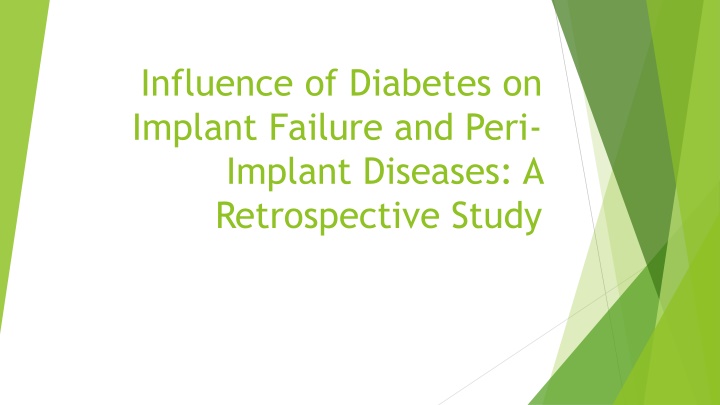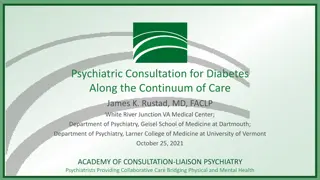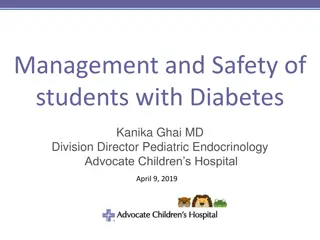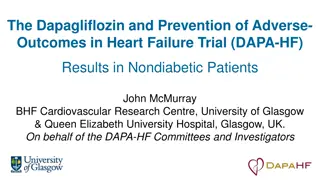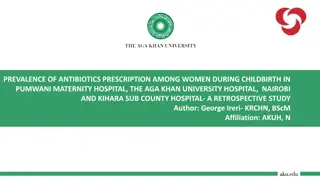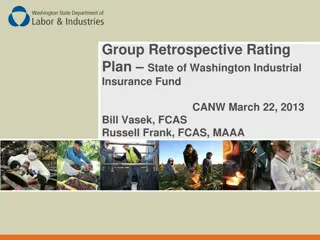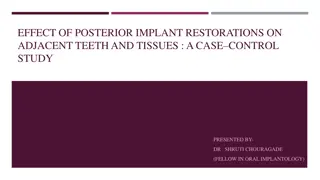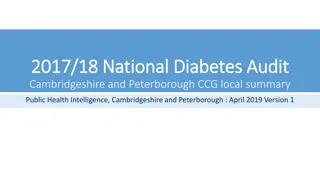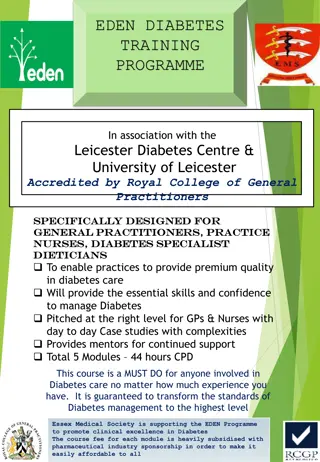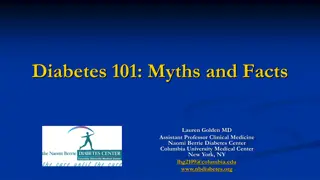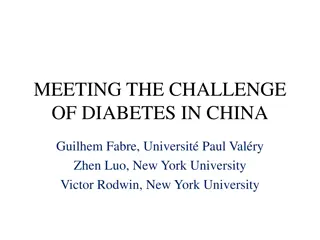Influence of Diabetes on Implant Failure and Peri-Implant Diseases: A Retrospective Study
In this retrospective study, the authors investigate the impact of diabetes on the occurrence of peri-implant diseases and post-operative complications at implant sites. The study aims to evaluate the relationship between diabetes and biological complications, specifically peri-implantitis, and assess its association with implant survival rates. The research sheds light on the potential influence of diabetes on implant failure and peri-implant diseases, offering valuable insights for dental professionals and patients.
Download Presentation

Please find below an Image/Link to download the presentation.
The content on the website is provided AS IS for your information and personal use only. It may not be sold, licensed, or shared on other websites without obtaining consent from the author.If you encounter any issues during the download, it is possible that the publisher has removed the file from their server.
You are allowed to download the files provided on this website for personal or commercial use, subject to the condition that they are used lawfully. All files are the property of their respective owners.
The content on the website is provided AS IS for your information and personal use only. It may not be sold, licensed, or shared on other websites without obtaining consent from the author.
E N D
Presentation Transcript
Influence of Diabetes on Implant Failure and Peri- Implant Diseases: A Retrospective Study
Authors Alice Alberti 1,2,* , Paolo Morandi 1,2, Beatrice Zotti 1,2, Francesco Tironi 1,2, Luca Francetti 1,2 , Silvio Taschieri 1,2,3 and Stefano Corbella 1,2,3 1 Department of Biomedical, Surgical and Dental Sciences, Universita degli Studi di Milano, 20122 Milan, Italy; paolo.morandi@unimi.it (P.M.); zotti.beatrice@gmail.com (B.Z.); francesco.tironi@unimi.it (F.T.); luca.francetti@unimi.it (L.F.); silvio.taschieri@unimi.it (S.T.); stefano.corbella@unimi.it (S.C.) 2 IRCCS Galeazzi Orthopedic Institute, 20161 Milan, Italy 3 Department of Oral Surgery, Institute of Dentistry, I.M. Sechenov First Moscow State Medical University, 119146 Moscow, Russia * Correspondence: alice.alberti@unimi.i
Introduction: In the last few decades, the scientific evidence on biofilm-related inflammatory peri- implant diseases has substantially increased. Peri-implantitis, which leads to progressive marginal bone loss around implants, represents the main cause of late implant failure. A new definition has been settled for peri-implantitis in the World Workshop on Periodontology (WWP) in 2017, where the diagnosis of peri-implantitis required: (a) the presence of bleeding and/or suppuration on gentle probing; (b) an increased probing depth compared to previous examinations (in the absence of previous examination: PD 6 mm); (c) further bone loss as compared to the initial bone remodeling (in the absence of previous examination: bone levels 3 mm apical of the most coronal portion of the intraosseous part of the implant). History of periodontitis and low hygiene levels are proven risk factors for peri- implantitis, while the role of other factors, including smoking status and diabetes, is still unclear.
Diabetes mellitus (DM) comprises a group of metabolic disorders characterized by hyperglycemia, which is due to the impairment of insulin secretion and/or action. The incidence of DM and its prevalence has been increasing significantly over the last few decades. The International Diabetes Federation estimated 451 million cases of diabetes in 2017, which represent a global prevalence of 8.4% and are expected to rise. While diabetes has been proven as an important risk factor for periodontitis, its association with peri-implant diseases has not been fully explored, and the existing literature reports controversial results.
Aim: The primary aim of this retrospective study was to evaluate the relationship between the presence of diabetes and the occurrence of biological complications at the implant site, namely the development of peri-implantitis and of post-operative complications. The secondary aim was to evaluate its association with implant survival rate.
Materials and Methods: The clinical records of all subjects treated with implants during the period between 1 January 2005, and 31 December 2018 in the Dental Clinic of the IRCCS Istituto Ortopedico Galeazzi (Milan, Italy) were screened. Inclusion criteria: (a) 18-year-old or older patients at the time of intervention (b) patients who gave their written informed consent for the use of their clinical records for research purposes (c) patients whose implants present complete clinical and radiographical records, including at least one radiograph per year and a report of complications. Patients lost at follow-ups were excluded from the study.
Outcomes: The primary outcome was the correlation between the presence of diabetes and the development of peri-implantitis. The secondary outcomes were: patient and implant-level cumulative prevalence of peri-implantitis, patient and implant- level cumulative implant survival rate, and prevalence of post-operative complications that occurred immediately after the surgical intervention.
Data Collection: The following parameters were collected: gender; age at the time of surgery; ASA score; presence of systemic diseases, smoking status, history of periodontal disease, and presence of diabetes In case of diabetes, diabetes type, diabetes therapy at surgery, glycaemia levels, and glycated hemoglobin (HbA1c) before surgery, glycosuria and leukocyte formula before surgery were also registered Implant type and characteristics (width, length); prosthesis type (fixed partial dentures, full arch fixed dentures, full arch removable dentures); date of diagnosis of peri-implantitis; date of implant loss/removal. The diagnosis of diabetes was formulated according to the American Diabetes Association guidelines. Peri-implantitis was defined as the presence of bleeding and/or suppuration on gentle probing, together with at least 2 mm bone resorption, evaluated through the comparison of baseline and follow-up periapical radiographs. All the clinical and radiographic records were re-analyzed to verify the diagnosis of peri-implantitis according to the most recent definition.
Statistical Analysis: The Shapiro Wilk tests served to evaluate the normality of the distribution of the variables considered. Descriptive statistics were provided by means of mean values and standard deviations for normally distributed variables. The cumulative survival rate was calculated by means of survival tables. The absolute patient-level prevalence of peri-implantitis was calculated for diabetic and non-diabetic subjects. Correlation between baseline parameters and outcomes was provided through the use of logistic regression. Odds ratio (OR) for diabetes as a direct cause of peri-implantitis and implant failure were calculated, adjusted for smoking status, history of periodontitis, gender, age, ASA score, presence of systemic diseases, implant type and characteristics, and prosthesis type) on survival curves. The level of significance was p < 0.05.
Results: A total of 204 patients and 929 implants were included. A wide range of implant systems were used, but all of them presented an internal connection with a polygonal design. Among all included subjects, 90 were males and 114 were females, the mean age at the time of surgery was 57.3 13.7 years, 127 had a history of periodontitis, 50 were smokers, and 18 were former smokers. The mean follow-up time was 5.7 3.82 years, varying from 3 months to 15 years after loading. Nineteen patients were diabetic, and most of them demonstrated a good control of the disease. Two subjects presented type 1 DM and were being treated with insulin, while seventeen presented type 2 DM; Among the diabetic patients, seven received a full-arch implant-supported prosthesis, three received an overdenture prosthesis, six fixed partial dentures, and seven were treated with multiple single crowns; three patients were treated with both fixed partial dentures and single crowns, and one with both an overdenture and a fixed partial prosthesis.
A total of 23 cases of peri-implantitis (patient-level) were registered, representing an overall prevalence of 11.3%. Only one diabetic patient (type 2) developed peri-implantitis (5.3%) whereas one subject with type 1 diabetes experienced multiple implant failures due to a failure of osseointegration.
Patient-level cumulative implant survival rate was 95.42% 10 years after surgery, which was 96.51% and 94.74%, respectively, for diabetic and non-diabetic patients, without any significant difference. None of the diabetic patients experienced post-operative complications. The OR for diabetes as a cause of peri-implantitis, adjusted for smoking status and history of periodontitis, was not statistically significant (OR = 0.47 (95% C.I. 0.06 3.76)). Similarly, the association between diabetes and implant failure, adjusted for the same proven risk factor, resulted not significative (OR = 1.23 (95% C.I. 0.11 13.30)). The results were adjusted for gender, age, ASA score, presence of systemic diseases, implant type and characteristics, and prosthesis type: none of the above-mentioned parameters were found to influence the development of peri-implantitis. The small number of cases among diabetic patients prevented us from considering diabetes type and therapy for statistical analysis.
Discussion: The results of our study revealed no association between diabetes and the occurrence of peri-implantitis, finding an insignificant OR in the examined cohort. Such results are coherent with those presented by Renvert et al. [11] who did not find a significant OR between a history of type 2 diabetes and peri- implantitis in a cohort of 270 subjects followed-up over time. It must be noted that in the above-mentioned paper, the authors adopted a definition of peri-implantitis that was different from here.
Ferreira et al. observed that diabetic patients were more susceptible to develop peri-implantitis, reporting a peri-implantitis prevalence of 24% in diabetic patients and 7% in non-diabetic patients. It must be noted, however, that these results refer to diabetic patients regardless of their glycemic control. Daubert et al. [13] also reported a relative risk of 4.1 for peri-implantitis in diabetic patients; however, their study included only five diabetic patients, which could have influenced the statistical analysis in both excess and defect. Venza et al. [14] found that some clinical parameters, including PD and radiographic bone loss, were significantly higher (p < 0.05) in poorly- controlled diabetic patients (HBA1c 8%), as compared to well-controlled diabetic patients (HBA1c < 8%). The authors thus suggested that a poor glycemic control may be involved in the modulation of periodontal destruction and could have a correlation with the severity of peri-implantitis
Our study only included one poorly-controlled patient, undergoing multiple implant failures. Therefore, no further analysis was possible regarding the development of peri-implantitis. In addition, the patient presented HbA1c 8.0, but lower than 9%, which is considered as moderately-controlled diabetes in some studies. Our study did not reveal any statistically significant association between diabetes and post-operative complications, but this could also be due to the small size of the DM group.
As for implant survival rates, the present study did not find any association with diabetes. A recent review published by Oliveira-Neto et al. in 2019 [5] came to the same conclusion, reporting that diabetes did not affect implant survival rate in two meta-analyses of high methodological quality
Conclusions: The actual influence of DM and hyperglycemia on peri-implantitis and implant failure is still uncertain and new studies on larger cohorts of patients are needed also taking into consideration further parameters, such as HbA1c baseline and follow-up values, baseline and follow-up diabetic therapy, and duration of diabetes. Future studies are needed to investigate the relationship between the long-term changes in glycemia and HbA1c levels and the health status of peri-implant tissues. Monitoring the main parameters of glycemic control is desirable not only for research purposes, but also for clinicians, since poor metabolic control may lead to complications such as increased risk of infections. Within the limitations of the present study, our results confirm that implant therapy in diabetic patients with good glycemic control should be considered a safe and viable treatment option
Author Contributions: Conceptualization, A.A., P.M. and S.C.; methodology, S.C., L.F. and S.T.; validation, S.C., L.F. and S.T.; formal analysis, S.C.; investigation, A.A., P.M., B.Z. and F.T.; data curation, A.A., P.M., B.Z. and F.T.; writing original draft preparation, A.A., P.M., B.Z. and F.T.; writing review and editing, S.C.; supervision, S.C., L.F. and S.T. All authors have read and agreed to the published version of the manuscript. Funding: This research received no external funding. Conflicts of Interest: The authors declare no conflict of interest
